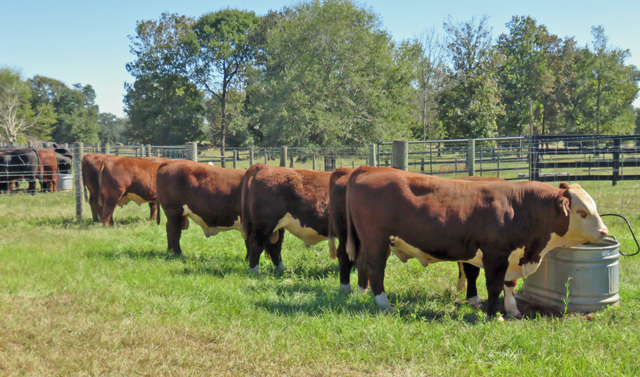
Bull selection at an auction or at the breeder’s farm can seem overwhelming with all of the data available. It helps to know the terminology behind the acronyms for each breed before you go shopping. Credit: Doug Mayo, UF/IFAS
Mark Z. Johnson, Oklahoma State University Extension Beef Cattle Breeding Specialist
Over the past 30 years we have seen the number of Expected Progeny Differences (EPDs) reported by beef breeds expand several times over. Over the past 20 years, $Values have been introduced in attempt to simplify selection. The past 10 – 15 years has seen the introduction of Genomically enhanced EPDs. This article defines and gives examples of each of these genetic selection tools.
An EPD is the prediction of how future progeny of an animal (bull or cow) are expected to perform relative to the progeny of other potential parents in a beef breed registry’s database. EPDs are reported in units of measure for that trait, plus or minus. For example, weaning weight is reported in pounds. A Heifer Pregnancy EPD (HP) is reported in percentage units. If comparing the following two bulls:
WW EPD HP EPD
Bull A 50 15
Bull B 61 10
Comparing the two bulls as parents, WW EPDs predict Bull B’s offspring to weigh 11 pounds heavier at weaning. HP EPDs predict Bull A’s daughters are 5% more likely to become pregnant as first calf heifers during their first breeding season.
$Value Indices or $Values serve as an economic selection index. A $Value assigns an economic weighting to several traits pertaining to a specific breeding objective or marketing endpoint. Accordingly, selection based on $Values will change several traits at once. Relative to a specific marketing goal, all the EPDs for traits that have economic impact on the value of offspring at that marketing endpoint are weighted and the genetic value is expressed as a single numerical value in dollars per head of offspring. For example, in Angus cattle, a Beef Value ($B) is a terminal index expressed in dollars per carcass. This index assumes commercial operations will retain ownership of all progeny through finishing and market fed cattle on a carcass value basis. As such, EPDs for the traits of yearling weight, dry-matter intake, marbling, carcass weight, ribeye area and external fat thickness receive an economic weighting. If comparing two bulls:
$B
Bull A 225
Bull B 201
Assuming the specific marketing endpoint for all progeny sired defined above, Bull A’s offspring should result in $24 more per carcass value.
Accuracy (ACC) indicates the reliability of the EPD and is based on the amount of data that has been taken into account in predicting the genetic value. EPDs based on the records of more ancestors, relatives, progeny and DNA will have higher accuracy values. ACC values range from 0 to 1 with values closer to 1 indicating more reliability (based on more data taken into account).
Genomically Enhanced EPDs (GE-EPDs) have taken DNA test results into account to enhance the ACC of EPDs. GE-EPDs are generally higher in ACC because DNA information is in addition to the pedigree, individual and progeny data. While EPDs are our best estimate of the breeding value of an animal in a breed registry for a trait regardless of ACC, GE-EPDs increase the accuracy of selection of young animals that have not yet sired or produced offspring.
More information and definitions of all genetic values reported by respective Breed Associations can be found in that breed’s Sire Summary or on their website.
Angus
Brahman
Charolais
Hereford
Red Angus
Simmental
- Federal Estate Tax and Gift Tax Limits Announced For 2026 - December 19, 2025
- Why Do I Have So Many Open Cows? Causes of Reproductive Failure - December 19, 2025
- Wiregrass Cotton Expo Offers Resources, Research, & Real Solutions for Growers in Southeast – January 22 - December 19, 2025
